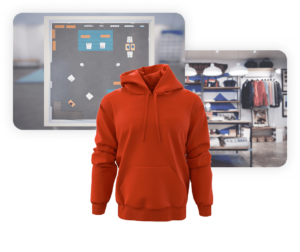The role of merchandising in retail and fashion has never been more dynamic—or more critical. Today’s merchandising leaders face a dual challenge: navigating the complexity of global markets and adapting to the rapid shifts in consumer preferences, all while maintaining speed, precision, and collaboration.
Many turn to Product Lifecycle Management (PLM) systems to manage product data, yet these tools are only part of the solution. To truly stay ahead, brands must bridge the gaps that PLM cannot address—enhancing collaboration, driving agility, and delivering data-driven insights. This is where VibeIQ steps in, providing an assortment lifecycle platform designed to complement PLM systems and empower merchandising teams to navigate the full scope of the go-to-market (GTM) process.
Where PLM Leaves a Gap in Merchandising Needs
What PLM Does Best: Managing Production Data
PLM systems are essential for managing production data across extensive product lines. They provide detailed oversight, track milestones, and ensure compliance, making them invaluable for maintaining consistency during the production phase. By centralizing product data, PLM systems serve as a reliable repository for finalized decisions and tracking progress in later stages of development.
The Gaps in PLM: Collaboration, Agility, and Early-Stage Alignment
While PLM excels in organizing data, it was not designed for the early, creative, and collaborative stages of the GTM process. Tasks like ideation, line planning, and cross-functional alignment require flexibility, speed, and real-time collaboration—areas where PLM systems often fall short.
For example, when merchandising and design teams work in silos, disconnected tools like spreadsheets and whiteboards create inefficiencies, slow decision-making, and hinder alignment. These gaps lead to delayed product launches, misaligned assortments, and missed market opportunities.
VibeIQ: Closing the Gaps with an Assortment Lifecycle Platform
VibeIQ transforms the way merchandising teams work by addressing the limitations of traditional tools and enabling smarter, faster, and more collaborative processes. It’s not about replacing PLM but complementing it.
Real-Time Collaboration Across Teams
VibeIQ provides a centralized platform where merchandising, design, and B2B sales teams can collaborate seamlessly. This shared environment ensures that everyone is working from the same source of truth, eliminating miscommunication and streamlining decision-making.
Impact:
By aligning teams early in the GTM process, VibeIQ accelerates product creation and iteration, reduces errors and helps brands bring cohesive, high-performing assortments to market faster.
Agility to Adapt to Trends in Real Time
In a fast-paced industry, the ability to quickly adapt to shifting trends is crucial. Unlike PLM, which manages established data, VibeIQ supports real-time adjustments, enabling teams to iterate on product lines and respond to emerging consumer preferences with confidence.
Impact:
Brands using VibeIQ gain the agility needed to stay ahead of competitors, ensuring their assortments align with the latest market demands.
Early Access to Actionable Insights
VibeIQ surfaces insights earlier in the GTM process, helping brands identify potential gaps or risks before they escalate. Teams can analyze product attributes, optimize assortments, and make data-driven decisions well before production begins.
Impact:
This early visibility reduces the risk of over-assortment, improves demand forecasting, and ensures that product lines meet both consumer and market needs.
Automation of Routine Tasks
VibeIQ automates time-consuming tasks such as updating spreadsheets, creating presentations, and entering data into multiple systems. This reduces the operational burden on teams, allowing them to focus on strategic initiatives.
Impact:
By automating repetitive processes, VibeIQ shortens the GTM calendar, helping brands capitalize on trends at their peak while minimizing human error.
Sustainability Through Better Alignment
With always-up-to-date product data and visuals, VibeIQ empowers teams to focus on designing and finalizing fewer but higher-performing products. This reduces sampling costs, eliminates waste, and avoids expedited shipping for last-minute changes.
Impact:
VibeIQ helps brands align with consumer values around sustainability, enhancing brand reputation while reducing costs and environmental impact.
Why Now? The Need for Higher Performing Assortments
In today’s hyper-competitive fashion landscape, speed alone is not enough—brands must move with confidence, backed by data-driven insights and seamless collaboration. VibeIQ’s assortment lifecycle platform bridges the gaps that PLM systems cannot address, enabling brands to optimize their entire GTM processes from concept to market.
Achieving Competitive Advantage with VibeIQ
By integrating VibeIQ alongside PLM systems, brands can unlock significant business benefits:
- Accelerated Time-to-Market: Launch products faster with streamlined workflows and automated tasks.
- Improved Alignment: Foster collaboration across global teams with a single source of truth.
- Optimized Assortments: Make data-driven decisions to align product lines with market demand.
- Sustainability Goals: Reduce waste and sampling costs while delivering higher-performing products.
Looking Ahead: A Smarter, Faster Future for Merchandising
As the retail and fashion industries evolve, the ability to integrate creativity, agility, and data-driven insights will define the leaders of tomorrow. VibeIQ equips your team to navigate these complexities, turning challenges into opportunities and positioning your brand for long-term success.
Ready to transform your merchandising strategy?
Contact us today to see how VibeIQ can help your team bridge the gaps in the GTM process and deliver stronger business outcomes.

